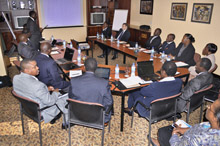
Typical street scene in Santa Ana, El Salvador. (Photo: iStock)
IMF Survey: IMF Promotes Better Economic Data in Africa
February 28, 2012
- Ghana, Uganda, Rwanda begin to disseminate quarterly GDP
- More frequent data on economic growth critical to policymakers
- Collaboration with regional center is key
The IMF is helping a group of sub-Saharan African countries produce and disseminate higher-frequency data on economic growth.

IMF workshop in Dar es Salaam, Tanzania. The IMF is helping countries improve quality of their economic data (IMF photo)
Technical Assistance
In April 2010 the IMF’s Statistics Department, with the support of the U.K. Department for International Development (DFID), launched a five-year initiative to help 23 African countries improve the quality and dissemination of economic statistics. Timely and high-frequency data are critical to helping both the private and public sectors make better economic decisions.
Based on a modular approach to assist groups of countries with similar needs, the initiative focused one of its modules on helping seven countries (Ghana, Kenya, Namibia, Nigeria, Rwanda, Tanzania, and Uganda) to produce and disseminate quarterly gross domestic product (GDP) data. This initiative is being implemented in close collaboration with the IMF’s regional center for east Africa, or East AFRITAC.
Early results
By the end of 2011, three of these countries—Ghana, Rwanda, and Uganda—had released quarterly GDP data to the public for the first time. In addition, Zanzibar began publishing quarterly GDP data, completing already published data by mainland Tanzania.
These earlier-than-expected results were welcomed by policymakers and other users in the business, financial, and international communities, because this kind of information provides much more timely indicators of economic activity than the previous annual statistics. This, in turn, provides a more accurate picture of the economic situation in each country at any given point in time.
The other countries participating in this module released some limited quarterly GDP data—mostly quarterly GDP at constant prices—and are working on expanding the series to compile quarterly GDP data at both current and constant prices, as well as improve the quality of all the data.
Speaking of the experience of Uganda, Tom Richardson, IMF Senior Resident Representative in Kampala noted Uganda’s Bureau of Statistics began compiling a quarterly GDP series several years ago, with significant support from the IMF, both from headquarters and from the statistics advisor at the IMF’s technical assistance center in Dar es Salaam, Tanzania. “They started to circulate the results informally within the government in 2010, and last fall began to disseminate the series to the public. In doing so, the Bureau of Statistics was responding to demand for higher frequency data on the real economy from market analysts, academic researchers, the business media, and especially the Bank of Uganda.
“The Bank of Uganda was particularly keen to have access to higher frequency real sector data because of their intention to modernize the framework for monetary policy in Uganda,” Richardson explained. “They have embarked on a set of reforms aimed at preparing the way for the introduction of full-fledged inflation targeting down the road. In the meantime, the availability of the new quarterly GDP series has proved invaluable in setting the context for the conduct of monetary policy. It no longer feels so much like the Bank of Uganda has to ‘fly without radar’.”
Working with regional centers
Collaboration among different technical assistance providers is an objective frequently stated but often difficult to achieve in practice. An innovative aspect of the quarterly GDP data module is that it has been implemented by the DFID-funded IMF initiative along with the IMF’s regional technical assistance center for East Africa in Dar es Salaam.
This collaboration has enhanced the scope and intensity of the module. The current initiative provides an overall design and management structure for the module on quarterly GDP data and funds all its technical assistance activities except the regional center’s missions to Kenya, Rwanda, Tanzania, and Uganda.
Action plans
Technical assistance under the quarterly GDP data module began in 2010 with an opening workshop, during which all seven countries worked with IMF officials in Washington and the statistics advisor in the Dar es Salaam technical assistance center to develop action plans for each country with specific inputs and results to be achieved. The workshop was followed by a series of missions to each country to provide hands-on training and advice. A second workshop in June 2011 took stock of progress and provided training to the whole group.
Further assistance will be provided to increase the quality of the quarterly GDP data estimates by
• increasing the use of value-added tax data provided by the finance ministries
• using more refined indicators for construction (currently limited to cement production)
• substituting better indicators for volume growth than population growth
• reducing the use of unreliable fixed coefficients in compilation methods
• improving price deflation measures, and
• updating the base years for the data.
It is expected that all seven countries will produce and disseminate both constant price and current price quarterly GDP data by the end of 2012 or at latest during 2013.


